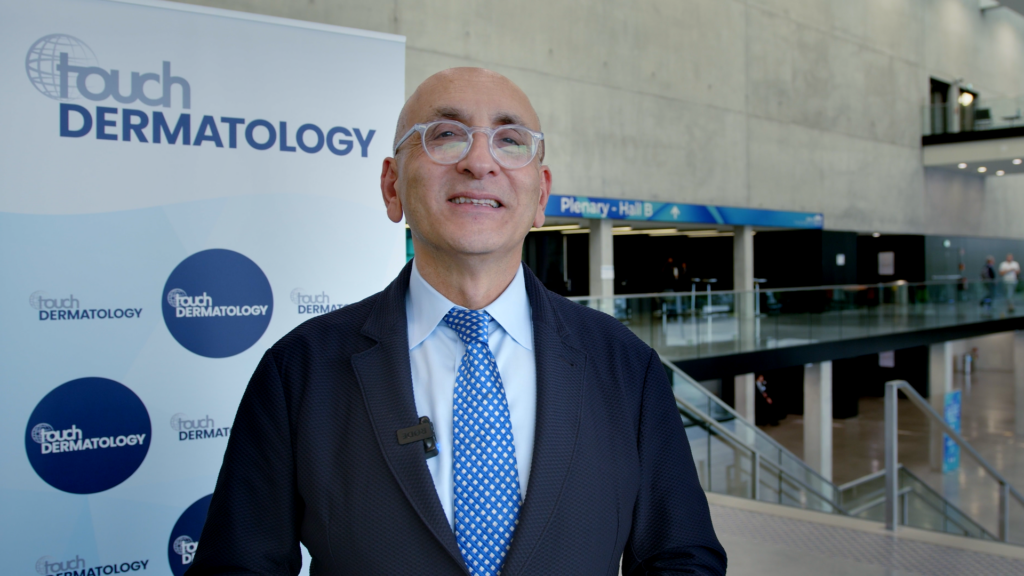TouchDERMATOLOGY coverage from AAD 2025:
We caught up with Dr Raj Chovatiya (Associate Professor at Rosalind Franklin University Chicago, IL, USA) at the 2025 American Academy of Dermatology (AAD) Annual Meeting, where he shared his personal highlights on the latest developments in chronic inflammatory skin conditions, including psoriasis and atopic dermatitis. In this expert interview, Dr Chovatiya discusses late-breaking data on three promising therapies—ESK001, icotrokinra, and rocatinlimab—and what they could mean for clinical practice. This discussion offers valuable insights for dermatology professionals seeking to stay informed on novel therapeutic approaches and their implications for practice.
Associated abstracts:
- Blauvelt A. Efficacy and safety of ESK-001, a highly selective oral TYK2 inhibitor, in moderate-to-severe plaque psoriasis: long term Phase 2 results. Late-breaking Research: Session 1. AAD, 7-11 March, 2025.
- Bissonnette R. Icotrokinra, a Targeted Oral Peptide That Selectively Blocks the Interleukin-23–Receptor, for the Treatment of Moderate-to-Severe Plaque Psoriasis. Late-breaking Research: Session 1. AAD, 7-11 March, 2025.
- Guttman E. Rocatinlimab Significantly Improved Clinical Signs and Symptoms by Targeting OX40R+ T cells in Patients with Moderate-to-Severe Atopic Dermatitis: Results from the Phase 3 ROCKET HORIZON Trial. Late-breaking Research: Session 2. AAD, 7-11 March, 2025.
Disclosures: Dr Raj Chovatiya has nothing to disclose in relation to this video interview.
Cite: Chovatiya R. #AAD2025: Essential updates in atopic dermatitis and psoriasis. TouchDERMATOLOGY. 26 March, 2025
This content has been developed independently by Touch Medical Media for touchDERMATOLOGY and is not affiliated with the American Academy of Dermatology (AAD). Unapproved products or unapproved uses of approved products may be discussed by the faculty; these situations may reflect the approval status in one or more jurisdictions. No endorsement of unapproved products or unapproved uses is either made or implied by mention of these products or uses by Touch Medical Media or any sponsor. Views expressed are the speaker’s own and do not necessarily reflect the views of Touch Medical Media.
[Transcript]
My name is Dr Raj Chovatiya. I’m an Associate Professor at the Rosalind Franklin University Chicago Medical School and Founder and Director of the Centre for Medical Dermatology and Immunology Research in Chicago, based in the USA.
So there’s probably 3 updates that I’ll focus on in the psoriasis and atopic dermatitis space that I thought were very, very interesting that were all presented as late-breaking research findings that hopefully have some implications for our future practice.
So the first I’ll talk about is an update, from a molecule, ESK001. It’s a highly selective oral TYK2 inhibitor, for moderate to severe plaque psoriasis. There was new data presented about long term phase II results. And so what the data showed is that for patients that were getting 40 mg twice daily dosing of this oral molecule, which again is a small molecule inhibitor of tyrosine kinase 2, an important signalling molecule that kind of connects IL-23 signal to IL-17 production.
What they found was that there was actually sustained or increasing clinical responses through week 52 when they compared to the first 12 weeks of data. So they found PASI 90 rates that were hanging out around the 60 something percent, full PASI 100 rates close to 40 percent, and even a full clearance on the PGA score nearly 40 percent as well. And this was in line with very highly significant improvement in itch as well as quality of life with pretty good safety and tolerability as well. The next, interesting update I’ll touch on is a molecule that there’s been a lot of buzz about, icotrokinra.
And this is an oral peptide, small peptide taken by mouth that blocks IL-23 signalling by binding to the IL-23 receptor. So in many ways, similar mechanism of action as an injectable biologic that binds IL-23. But this one works through binding the receptor in a small molecule, rather small peptide format. So in the ICONIC-LEAD study, what they found was actually about 2/3 of patients that had once daily medication actually had a score of clear or almost clear and really quite remarkably about, you know, let’s say about 40 percent of them got to a PASI 100 rate, and another 45, 46 percent of them hit a total clearance rate on the IGA scale as well. And these are some of the highest numbers that we’ve really seen in an oral molecule package, and so it’s pretty exciting from that standpoint.
I’ll touch on one disclosure in atopic dermatitis as well. This is rocatinlimab.
This is a molecule that is a monoclonal antibody that binds and blocks OX40. OX40 is a receptor found on activated t cells, And the idea with this mechanism of action is that by removing overly activated pathogenic activated T cells, one could actually normalize the inflammatory milieu in atopic dermatitis.
And so the data that we saw presented at AAD was the ROCKET HORIZON trial. All of the co primary and key secondary endpoints were met. It’s worth noting that EASI 75 at week 24 was achieved by about a 1/3 of patients compared to maybe somewhere around just over 10 percent of the placebo group. And from a clear or almost clear score, about 20 percent of the patients that were treated with rocatinlimab compared to maybe only around 6 percent of placebo as well. It’s also important to note that from a safety and tolerability standpoint, for the most part, roketinumab was pretty well tolerated. There was slightly higher rates of pyrexia, chills, and headache that were noted generally in the early phase of treatment with individuals that were treated with rocatinlimab.
For molecules that have yet to be fully approved by regulatory bodies. So there is a lot of excitement and questions about where these are going to fit in an already crowded landscape for diseases like psoriasis and atopic dermatitis. So in the case of a molecule like, let’s say, ESK001 or even, icotrokinra, you have 2 oral molecules that are showing good safety and good efficacy. And knowing that we’ve had a boom in injectable biologic therapies over all this period of time, we really haven’t had much in the way of thinking about some of our, you know, oral options.
And so it’s very exciting that we may have additional highly effective oral molecules that really allow us to tell our patients, would you like an injection? Would you potentially like a pill? And you’re not going to have too much of a drop off in terms of potentially thinking about efficacy, which in our minds usually is lower when it comes to thinking about oral molecules. In the case of rocatinlimab with atopic dermatitis, it’s a slightly different question.
Most of our therapies are really focused in on downstream mediators of inflammation in this particular disease state, and this is potentially gonna be one of the first that’s taking a view upstream and really trying to recentre our understanding of this disease state around the interaction between antigen presenting cells and T cells. And rocatinlimab, tries to leverage a cool idea of really targeting the broad array of T cells, not just type 2 T cells, but Th1, Th17, Th22 that are all important for atopic dermatitis and really trying to remove them and their memory cells from the picture to see if we can really reset the immune system in the long run and potentially make some clear long term changes for this disease.
SIGN UP to TouchDERMATOLOGY!
Join our global community today for access to thousands of peer-reviewed articles, expert insights, and learn-on-the-go education across 150+ specialties, plus concise email updates and newsletters so you never miss out.
Further content in the field of Dermatitis, Psoriasis, Autoimmune Diseases
Editor: Gina Furnival, Senior Editorial Director











